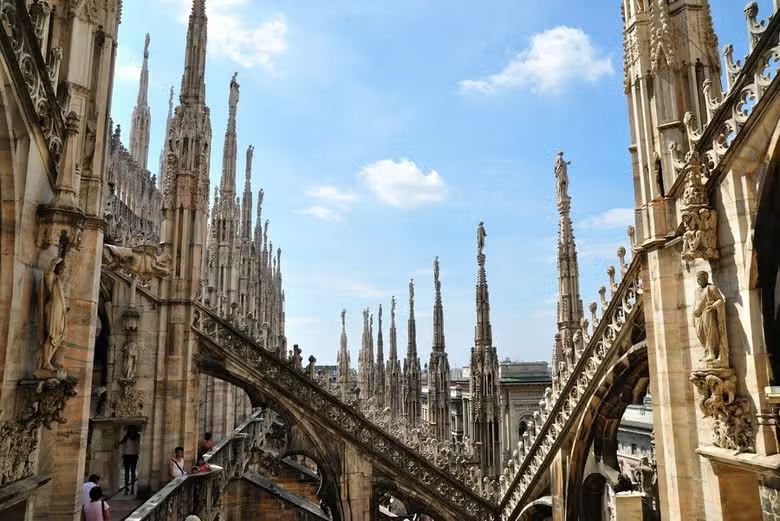About Milan



The time zone in Italy
CET (Central European Time) applies throughout Italy. From
early autumn to late winter, standard time applies,
corresponding to the time zone UTC+1, one hour ahead of
Greenwich Mean Time.
At the beginning of spring, Italy enters daylight saving
time: the clocks move forward by one hour (UTC+2 time zone),
to enjoy more sunlight in the late afternoon-evening.
The change from standard time to daylight saving time and
vice versa always takes place on the night between Saturday
and Sunday. The dates vary from year to year.
Italian meal times and usual daily routines
Italians normally have breakfast from 7.00 a.m., but some
bars and pastry shops open as early as 6.00 a.m. Hotels
usually have a set time (approximately 10.00 a.m.) at which
breakfast ends. Room service is generally available for
requests outside these hours.
Lunch in restaurants, farmhouses, diners or bars is usually
served from 12.30 p.m. to 2.30 p.m. On special occasions or
events, the start and duration of lunch may vary.
The “aperitif” is not to be missed: it takes place roughly
from 6 p.m. until dinnertime.
Dinner is normally served from 7.30 p.m. until 11 p.m.
You can also find venues offering a late dinner, for after a
theatre performance or for those who prefer to eat late at
night.
Phone calls, internet and data roaming in Italy
Internet, Wi-Fi and data roaming in Italy
If you do not have a tariff plan that allows you to use the
data network at no extra cost, we recommend using the Wi-Fi
networks in Italy. As well as the free Wi-Fi networks in
Italy provided by hotels and on means of transport, such as
Wi-Fi on trains, you can also use Wi-Fi offered free of
charge by many commercial establishments, such as bars and
restaurants, attractions, cultural venues, etc.
Another very useful service is Piazza Wi-Fi Italia, the
national network of free internet access. Before leaving, we
recommend downloading and registering on the wifi.italia.it
app (available for iOS and Android). Thanks to the
geo-located map (also downloadable for offline use), this
will allow you to easily locate the nearest Piazza Wi-Fi
Italia hotspot.
You can also use a SIM card from an Italian operator
offering your desired amount of GB.
Data roaming. A word of warning: it is a good idea to inform
yourself about available offers and tariffs beforehand, to
avoid unknowingly running out of credit. If your tariff plan
includes additional costs for roaming, we recommend
connecting to a Wi-Fi network. For information on roaming
services and any additional costs, you can
check the
dedicated page on europa.eu.
Mobile phones and SIM cards in Italy
The Italian mobile network is based on LTE technology. The
4G network is the most widespread and ensures an average
coverage of 99.3% across the country. 5G is currently only
available in Milan, Bologna, Turin, Rome and Naples.
To call an Italian telephone number from abroad, you need to
dial the Italian dialling prefix and international calling
code 0039 (+39), followed by the user’s telephone number,
whether calling from a landline or a mobile phone.
To call from Italy to another country, you need to dial 00
(+) with the international dialling code of the country you
want to call, followed by the number you want to reach.
Depending on the length of your stay, we recommend
purchasing an Italian SIM card to keep costs down. For calls
within Italy, simply dial the telephone number without the
country code. There are fewer and fewer telephone booths in
Italy, but some can still be found on the street, in some
establishments, and in shopping centres: they work using
coins or cards that can be bought at tobacconists,
newsagents and phone shops.
To call a landline in Italy, remember that each telephone
number is preceded by a prefix that varies from area to
area. Both must be included. To find out the area code of
the location of your stay, you can check the
Pagine Bianche
website.
In Italy the single, free emergency number is 112, which you
can dial without an area code. It will put you in touch with
an operator who, in turn, will redirect you to the
appropriate authority.
There are also other emergency numbers in Italy for specific
areas: 113 for the Polizia di Stato (state police), 115 for
the Vigili del Fuoco (fire brigade), 117 for the Guardia di
Finanza (financial police), 1515 for the Guardia Forestale
(forest rangers), 1518 for Viaggiare Informati (traffic
information), 803.116 for Aci Soccorso Stradale (roadside
assistance) to request a breakdown recovery vehicle in the
event of an accident or breakdown, including on motorways.
118, on the other hand, is the number to call to request an
ambulance if you need access to an accident & emergency
room, including paediatric emergency rooms, and, in general,
for emergency and urgent medical services.
How to get to Milan
Milan is in the north of Italy and is easily accessible both
by land and by air. It's Italy’s international gateway with
three good-sized international airports. These are the
easiest and fastest ways to get to Milan depending on where
you're departing from:
For more details , please check the information in the link
below:
https://www.introducingmilan.com/how-to-get-to-milan
Transport
Public transport in Milan is quite efficient, is relatively
cheap and runs until late. However if you are staying in the
centre, it's most likely that you'll only use it to get to
the airport
If your hotel is not too central and you plan to use public
transport on a regular basis, a good way to save money is to
buy the Milan Pass, which allows you unlimited use of public
transport and includes admission to the city's main
attractions.
You can see all the information and buy it through the
website at this link:
https://www.introducingmilan.com/transport


